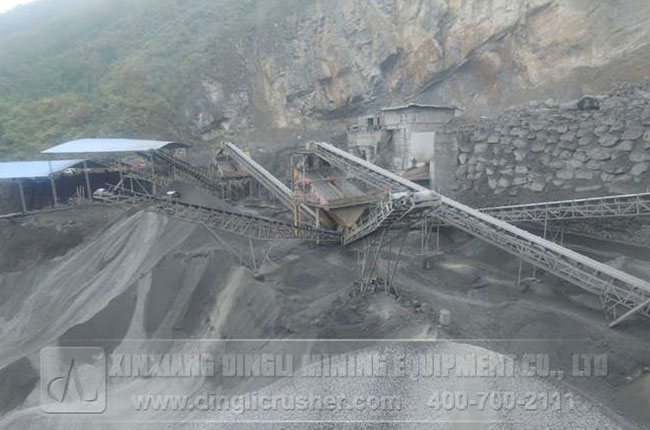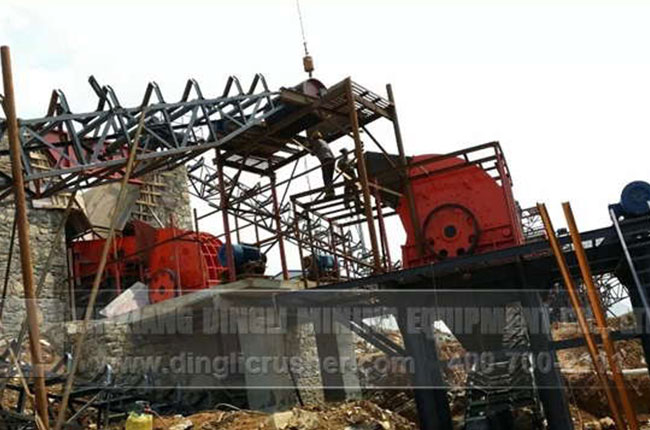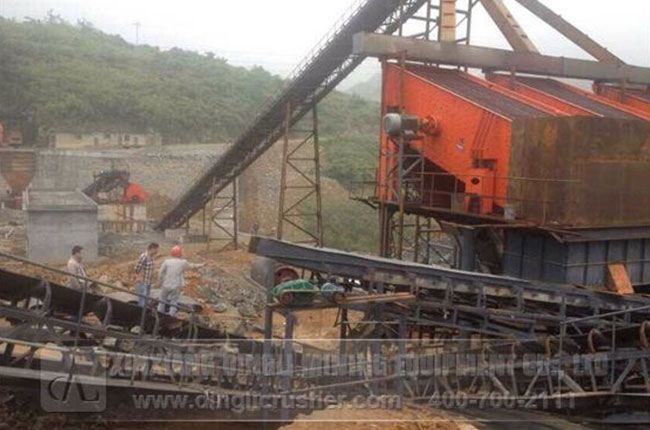 Sand Aggregate IndustryComprehensive Service Provider
Sand Aggregate IndustryComprehensive Service Provider Sand Aggregate IndustryComprehensive Service Provider
Sand Aggregate IndustryComprehensive Service Provider| Model | PYF1000 | |||
| Cavity Type | C | M | F | EF |
| Maximum feed size (mm) | 160 | 115 | 80 | 50 |
| Discharge opening adjustment range (mm) | 13-38 | 10-25 | 6-19 | 6-19 |
| Processing Capacity (t/h) | 80-235 | 65-150 | 52-115 | 50-102 |
| Motor power (kw) | 90-110 | |||
| Machine weight (t) | 10.8 | 10.51 | ||
*Note: The processing capacity of the PYF1000 cone crusher may vary with different materials and feeding sizes.

In this production line we get to know that the bulk material should be firstly crushed by crusher for large size finished material and then it is crushed into smaller ones for little stones.

The operating process of this 400tph production line is crushed by PCZ heavy hammer crusher shaped by PCX shaping hammer crusher graded by vibrating screen and then sent qualified stone into finished material stockpile.

This is a crushing production line established by cement industry that can crush not only limestone but clay and gypsum with high efficiency full crushing and lower wear-resistance.
The PYF1000 cone crusher is a significant piece of equipment in industrial crushing operations. Understanding how it fits into production lines and evaluating the associated costs are crucial for achieving efficient and cost-effective production.
When integrating the PYF1000 into a production line, the feeding system is a key consideration. With its different cavity types having varying maximum feed sizes, from 50 mm for the EF cavity to 160 mm for the C cavity, the choice of feeder must align accordingly. For the C cavity, a vibrating feeder with a larger hopper capacity and an adjustable feed rate capable of handling materials up to 160 mm is necessary. This ensures a consistent supply of raw materials to match the crusher's processing capacity range of 80 - 235 tons per hour. Similarly, for the other cavities like M, F, and EF, the feeder should be selected to provide a steady flow of materials within their respective maximum feed size limits to prevent issues like overloading or underfeeding the crusher.
The crushed materials from the PYF1000 need to be efficiently transported to subsequent stages in the production process, making conveyor belts essential. The width and speed of the conveyor belt should be determined based on the crusher's processing capacity and the size of the output materials. For example, when the crusher is operating at higher capacities, especially with the C cavity, a wider and faster conveyor belt is required to handle the larger volume of crushed products. Additionally, the conveyor's design should account for factors like the discharge height and angle to ensure smooth transfer of materials to downstream equipment such as screening machines or storage bins.
Screening and sorting equipment play a vital role in classifying the crushed materials from the PYF1000 according to different size fractions. The discharge opening adjustment ranges of the various cavities (ranging from 6 - 19 mm for the EF and F cavities to 13 - 38 mm for the C cavity) determine the size distribution of the output. The mesh sizes of the screening machines should be carefully chosen to match these ranges. This enables effective separation of the crushed materials into desired product sizes, facilitating the creation of consistent and marketable end products. By properly coordinating with screening equipment, the PYF1000 can be integrated seamlessly into a production line that maximizes the value of the crushed output.
The initial cost of the PYF1000 cone crusher includes not only the purchase price of the equipment itself but also associated expenses like installation and setup. The motor power range of 90 - 110 kw and its machine weight of 10.8 tons may impact transportation and installation costs. Additionally, any modifications needed at the production site to accommodate the crusher's footprint and power requirements should be factored in. However, considering its diverse cavity types and corresponding processing capacities, it offers the potential for significant production output, which can justify the initial investment over time.
Operating costs mainly consist of energy consumption and wear part replacements. With a motor power in the 90 - 110 kw range, energy usage is a significant factor, especially during continuous operation. Monitoring and optimizing the crusher's usage patterns to minimize idle time and run it at efficient load levels can help control energy costs. In terms of wear parts, components like the mantle, concave liner, and bearings are subject to wear due to the crushing process. Regular maintenance and timely replacement of these parts are necessary to maintain performance. The frequency of replacement depends on factors such as the hardness of the materials being crushed and the operating hours, and these costs should be budgeted for to ensure the long-term smooth operation of the PYF1000.
When assessing the overall cost of the PYF1000 in a production line, conducting a long-term cost-benefit analysis is essential. By considering its processing capacity, the quality of products achieved through proper integration with other equipment, and the potential revenue generated from the final products, businesses can determine whether the investment in the PYF1000 is worthwhile. Over its operational lifespan, if it enables increased production efficiency, reduces the need for additional crushing equipment, and results in higher-quality end products that command better market prices, the overall costs can be offset by the benefits it brings to the production process.
The PYF1000 cone crusher's ability to integrate well into production lines and the careful management of its associated costs are vital for maximizing its value in industrial applications. By understanding these aspects, businesses can make informed decisions to ensure the efficient operation and economic viability of using this equipment.
We are present worldwide and always here to help.
Get in touch today!